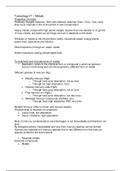Toxicology 07 – Metals
Properties of metals
Positively charged (cationic), often with different valences (Fe2+, Fe3+, Fe4+) and
they occur naturally in the environment in low concentration.
Heavy metals; metals with high atomic weight, heavier than iron density of >5 g/cm3.
→ toxic metals, but watch out all things are toxic it depends on the dose.
Emission of metals to the environment; traffic, household waste, energy plants,
power lines, agriculture and industry.
Direct exposure; through air, water, soiled.
Indirect exposure; eating contaminated food
Toxicokinetic and toxicodynamic of metals
▪ Speciation; refers to the chemical form or compound in which an element
occurs in both living and non-living systems. (different form of metal)
Different species of mercury (Hg);
• Metallic mercury (Hg0)
o Through food; poor absorption, not so toxic
o Through air; high absorption, toxic
• Insolute mercucry salts (HgS)
o Through food; poor absorption, not so toxic
• Free mercury ion (Hg2+)
o Through food; poor absorption, but very toxic
• Alkylated mercury compounds (CH3Hg+ etc.)
o Through food; high absorption AND very toxic
Metallic mercury; effect on brain and nervous system.
Physical state is important for exposure;
• Liquid; food, low absorption.
• Damp; inhalation, high absorption.
Most of mercury contaminations (verontreinigen) is not bioavailable and therefore not
toxic.
By biological activity, bioavailable and very toxic mercury species can be formed
Humans are exposed to a mercury species that is very different from the mercury
species emitted to the environment
▪ Essential metals
Essential compounds;
• Metals;






